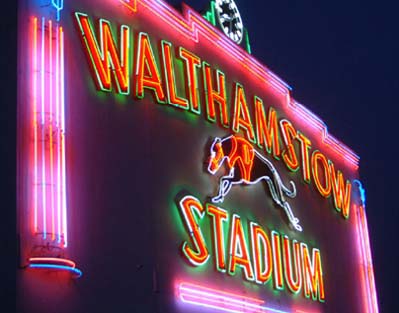
“Walthamstow Stadium is now Closed
The last race greyhound meeting was held at the stadium on Saturday 16th August 2008.
The Chandler Family would like to take this opportunity to thank all their staff & customers for 75 years of great service.â€
This is the notice that now appears on the homepage of Walthamstow Stadium’s website. It’s incredibly sad to hear that the greyhounds raced around Walthamstow Stadium, in northeast London, for the final time on Saturday night.Â
The closure of Walthamstow now leaves Britain with 29 registered greyhound tracks, and London with only one – Wimbledon. At the sport’s postwar peak, 50 million a year packed into 77 tracks. But the shift to betting in shops and online has hit tracks hard. Despite £2.3 billion a year gambled on greyhounds, turnover at the Walthamstow tote fell from £16.85 million in 1989 to £8.76 million last year. Before the sale was announced three months ago, attendance at the Stow had slumped to a couple of thousand on Saturday and a couple of hundred on a wet Tuesday.
The Stow, as it was affectionately known, was built in 1933 by William Chandler, a street-corner bookmaker, and had been owned by his family until its sale this year to property developers and a housing association for an undisclosed sum. The decision caused a lot of bad feeling, but the Chandlers point to losses of more than £500,000 for the year ended February 2008. Charles Chandler, the company chairman, said that he was deeply upset, but the business had become unsustainable.
The early appeal of greyhound racing to Britain’s working men is easy to explain, says Lord David Lipsey, a Labour peer and chairman of the British Greyhound Racing Board: “At that time, a working man couldn’t get a legal bet except at a dog track – he couldn’t get credit at a bookmakers. Greyhound tracks were also a lot cheaper to get into than racetracks, and far easier to get to.” The sport, Lipsey says, is “deeply embedded in a certain kind of cultural life.” Even before it closed, entrance to a weekday night of racing in the Popular Enclosure at Walthamstow is yours for a quid (and free for under-15s).
TS Eliot argued, in Notes Toward a Definition of Culture, that for a nation’s culture to be truly complete it must be composed of the high and the popular variety – of Derby Day at Epsom, the Glorious 12th, and a night at the dogs.
North London has lost a place of popular culture to be replaced, no doubt, by a bland housing estate which will offer little to the local community.
Â
Posted in EVENTS & PASTIMES | Comments Off on END OF THE STOW
In a recent post, Jennifer Hodgson, a commentator on English culture, observed what she considered to be the anachronistic nature of this project. She thought that the events I had chosen to photograph, and the components that constituted them, were archetypally English, drawing on nostalgic visual codes and serving to underline an imagined view of England, one that was not necessarily rooted in contemporary reality. This raises many interesting questions.Â
Firstly, perhaps there is the presumption that any attempt to record Englishness is part of an attempt to re-construct it or re-define it, as opposed simply to recording what one finds. In other words, I don’t have an agenda, as Tony Ray-Jones did, for example, when he set out in the late 1960s to record the English way of life before it became more Americanised.Â
Indeed, a selection of the ideas for this project have come from my website, where people have posted up their suggestions of events for me to photograph. This is important, as the photographs reflect a generalized, hopefully widespread visualization of England, not just my own vision. These events do, however, reflect people’s conception of and notion of Englishness. Many of them are traditional fetes, fairs, races and sports activities, which can appear rather mundane, or unimaginative; English life at its most predictable and stereotypical. But this is not a kind of unconscious national attempt to consolidate a frail notion of English identity. It is, I believe, a simple reflection of local life for the majority of people.Â
On the whole, people are doing what they have always done; they congregate in open spaces, on the beach or beside lakes and rivers, they eat food and drink and spend time with friends and family. They play sport and listen to music; they really do converge on the village green or the nearest playing field. Seen from this perspective, we may appear, as a nation, to lack diversity in terms of how we express our preferences and interests. Additionally, there are a number of traditional English elements to an event, for example, Punch and Judy shows or Morris Dancing that are enjoying a revival. The current enthusiasm for fetes, fairs and festivals is a reflection of changing fashions and such events are definitely in vogue once again.
This is my personal, grass roots experience. There is no doubt, however, that county councils and large organizations are utilising traditional ideas and references to market their events. This is a point that I want discuss in more detail in a later post, however, I just want to highlight one such example now. In many ways the Gloucestershire cheese rolling festival could be seen as an extreme example of Englishness being bottled and branded, with television coverage, a press compound and a £300 fee just for a photographer like me to record the event. I chose not to do so because I felt uneasy with the cynical self-consciousness on the part of the organizers to present the world with what they believed was typical Englishness (or maybe the event has just become a victim of its on success). Clearly, the cheese rolling has become a media circus and bares very little relation to ‘normal’ life.
Â
Posted in ENGLISHNESS, EVENTS & PASTIMES | Comments Off on AN ANACHRONISTIC APPROACH?
I was at Edgbaston cricket ground in Birmingham this past weekend to photograph the third test between England and South Africa (which we lost). I wasn’t so interested in the cricket as the crowds watching. It was a carnival atmosphere in the summer sunshine with nearly half the spectators (mostly middle class, white men) clad in a plethora of bizarre fancy dress outfits. Costumes ranged from cowboys, strippers and zorro to superheroes, cavemen, and my personal favourite, Amy Winehouse.
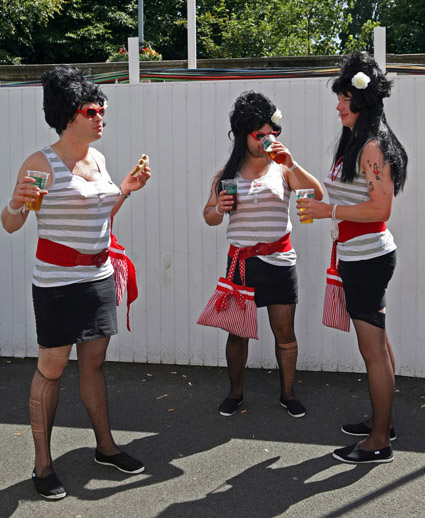
Â
And of course the Barmy Army were in full force.
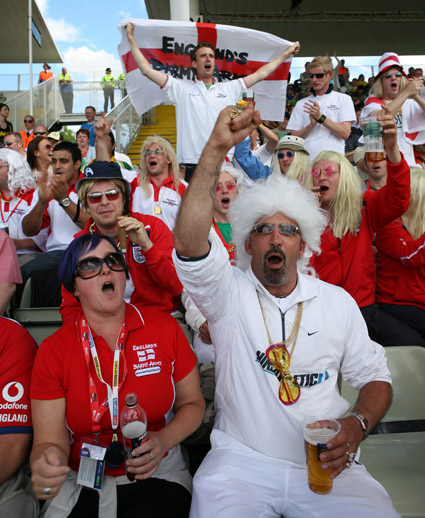
Â
Posted in EVENTS & PASTIMES | Comments Off on WINEHOUSE AND THE BARMY ARMY
Continuing my weekly dispatch in The Times, week 9 was taken in New Brighton, Merseyside.
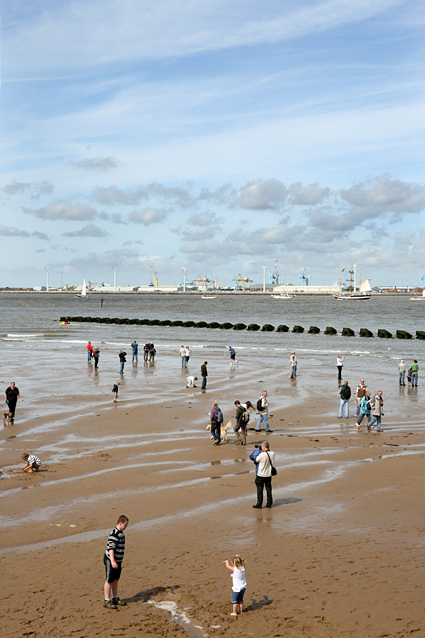
New Brighton, 21st July 2008
Spectators gather on New Brighton beach as the last of the Tall Ships sail out of Liverpool on the River Mersey. Over 60 sailing ships were moored in the city’s docks for the start of the annual Tall Ships Race, creating scenes reminiscent of Liverpool’s historic past.
Â
Posted in EVENTS & PASTIMES, POSTCARDS | Comments Off on POSTCARD IN THE TIMES – WEEK 9
Literally!
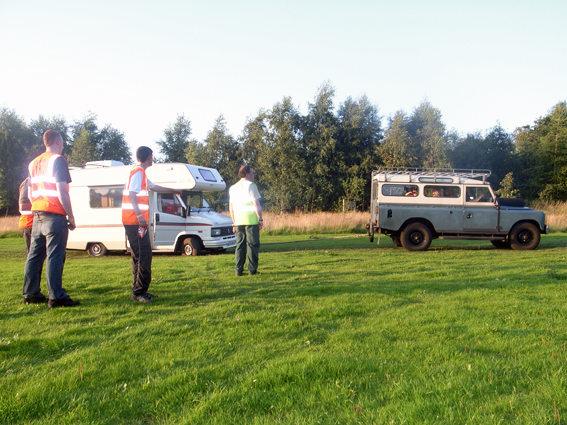
We had to be pulled out of a waterlogged field tonight after attending the Burnley Show & Hot Air Balloon Extravaganza. This is one of those examples of local tourist boards getting over excited with their marketing description – there were just two hot air balloons?! Hardly an extravaganza.
However, they did have the “Grand Finale of Burnley’s Got Talent” and a “world record attempt” by the rather fabulous John Evans, aka the Head Balancer.
“John Evans is a legendary strongman, who has delivered his own brand of unique entertainment over the pass two decades. Whose shows have astounded thousands of people. Incredibly, he balances immensely heavy objects, such as bricks and even cars, on his head.”
Here he is in action, carrying car tyres and beer crates on his head-
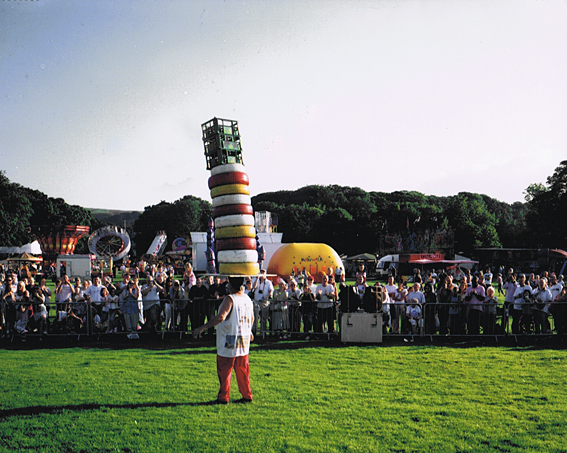
You can also watch him perform in Mansfield town centre on You Tube here and there are also some amusing video clips, including carrying a red Mini on his head, on his website here.
Posted in EVENTS & PASTIMES | Comments Off on STUCK IN THE MUD
I had an enjoyable day last Friday photographing at The Open golf tournament held at Royal Birkdale in Southport. Not being a golf player or follower, it was fascinating to witness the passion with which the sport instills in its legions of fans. Just over 50,000 had turned out to brave torrential rain and gale force winds to follow some of their favourite players around the course.
Given the popularity of the sport, I suppose I shouldn’t have been surprised by the media centre (where I collected my accreditation), which was the size of an aircraft hanger. Along with the photographers and camera crews, there were literally hundreds of journalists sat behind computer screens tapping out up to the minute stories.
It was amusing walking around the course with my 5×4 camera and being greeted with perplexed glances by the golfing photography community. I was certainly the only one still using film.
I’ve always had a great deal of respect for sports photographers. I even spent a few days doing work experience alongside the talented Sports Illustrated photographer Bob Martin after winning a competition to spend two weeks photographing at Wimbledon.
Two of my favourite sport photographs are by another Sports Illustrated photographer, Neil Leifer. Both photographs are of Muhammad Ali from the 1960s and the first was taken during Ali’s bout against Cleveland Williams at the Houston Astrodome on November 14, 1966.
Â
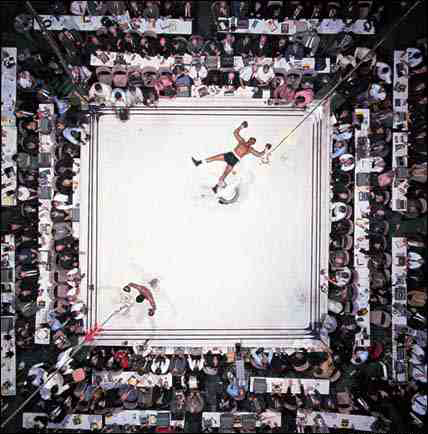
© Neil Leifer
Â
The second was taken on May 25, 1965, when Ali stopped Sonny Liston with one punch in the first round of their heavyweight championship fight in Lewiston, Maine.
Â
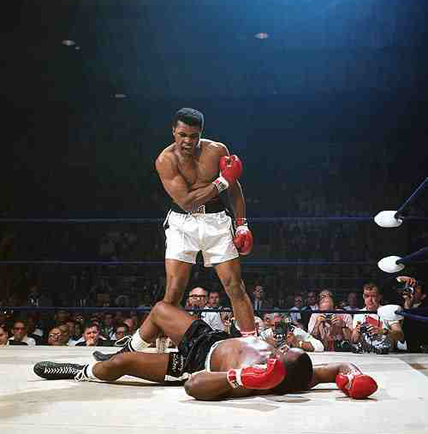
© Neil Leifer
Â
They are both extraordinary images. One of the things that strikes me most looking at them over forty years later is the absence of any advertising branding, which gives the photographs such purity.
Here is a quote from Leifer taken from Digital Journalist where he describes both pictures-
“Part of being a great photographer is being lucky enough to be in the right spot at the right time like I was, but a more important part is not missing when you’re in that spot. I got very lucky at the Ali-Liston fight, but what I’m proudest of is that I didn’t miss. It’s always assumed that the Ali-Liston picture is my favorite. Not so–I took my all-time favorite picture at another Ali fight one and a half years later. Photographers had mounted cameras on the light rigging above the ring before, only they had pointed them down, from the corners, so that they could capture the fighters’ facial expressions. Because the lighting rig was usually only about 20 feet above the canvas, even the widest of wide-angle lenses wouldn’t allow you to capture the whole ring. But the Ali-Cleveland Williams fight was in the Astrodome, where for the first time, the rig would be about 80 feet up, so it wouldn’t block the sightlines of spectators in the upper deck. I realized at that height, you could get the entire ring in the picture, and that it would be perfectly square. Ali-Williams is my personal favorite picture, but I know that 100 years from now, Ali-Liston is the one picture that everybody will remember me by.”
You can read a longer interview with Leifer written in 2002 here.Â
Â
Posted in EVENTS & PASTIMES, MISCELLANEOUS | Comments Off on SPORTS PHOTOGRAPHY
I mentioned research published by Professor Danny Dorling in an earlier post last week. One of his colleagues, Professor Nicky Gregson, who also happened to be my university tutor, has conducted extensive studies into the social phenomenon of the car boot sale. Having just been to the Chelford car boot I thought it might be of interest to post up some of her research findings – especially as over a million people enjoy haggling and finding curious, useful and sometimes (in)valuable items at car boot sales every weekend.
Professor Gregson was one of the first people to do academic research into these events, exploring the car boot as marginal spaces of contemporary consumption. Her various studies were conducted alongside Louise Crewe of Nottingham University and you can see abstracts from their research papers here, here and here.
Their research found that the most popular buys were children’s clothes. Items bought to “sell on” included clothes and equipment for babies, videos, kitchen utensils and DIY tools. The maximum number of purchases by a consumer recorded was 94 and the most spent was £100. Far from being the poor and unemployed, 40 per cent of buyers were employed; 16 per cent in part-time work and 21 per cent retired. Two-thirds of the comsumers surveyed were aged 25-55 and men and women were found to be fairly evenly represented at the sales. Women typically bought and sold children’s clothes, toys, ornaments and household goods with men showing greater interest in things such as DIY equipment, gardening tools and car accessories and parts.
You can find out more about Gregson’s recent research into ‘Disposal, Devaluation and Consumerism’ here.
And if you’re looking for a car boot near you, visit www.carbootjunction.com.
Â
Posted in EVENTS & PASTIMES, RESEARCH | 1 Comment »
Where exactly is the middle of England? Many guess the answer is Meriden, near Coventry, where an ancient monument marks the “traditional centre of Englandâ€. In fact, the geographic centre of England is in a paddock at Lindley Hall Farm, outside the village of Fenny Drayton, owned by Margaret Farmer (aged 86). We paid a brief visit to the farm this week.
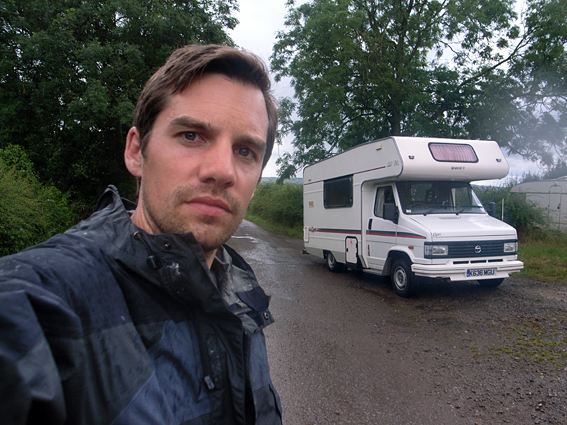
Â
The nation’s chief mapping agency, the Ordnance Survey, has calculated the exact centre of England at grid reference SP 35373.66 96143.05 (a point just a couple of hundred metres from Mrs Farmer’s house).
When the BBC visited Mr and Mrs Farmer in 2002 (Mr Farmer has since deceased) the couple said they were “surprised†to learn their farm was special. Mrs Farmer said: “We like it here because it is nice and peaceful and it is good land.â€Â The farm has been in the family for 41 years. It was formerly a dairy farm, but all its animals were destroyed following the outbreak of foot-and-mouth disease. It is now being farmed for sheep, cattle, wheat, oats and barley.
Commenting on the suggestion they should build tearooms and possibly American tourists would come out, Mrs Farmer said “I think we are a bit old for all that”. How refreshing!
However, citizens of Coventry are obviously proud of their status as being the closest city to the centre of England. As proved by this music fan I came across at this weekend’s Godiva Festival, which read: “Coventry- North of London, South of Manchester, Heart of England.”

Â
Posted in EVENTS & PASTIMES | Comments Off on THE CENTRE OF ENGLAND
Today sees one of the finest events in the annual English sporting calendar taking place. And no it’s not the semi-finals at Wimbledon, the Henley Regatta or the practice run of the British Grand Prix at Silverston, but rather the highly competitive, highly sophisticated Oxted Pram Race. Having been a regular at the pram race in my teens, I’m extremely disappointed not to be able to document it for this project but our tight schedule demands that we are here in Coventry.
The annual Oxted Pram Race takes place on the Friday evening before the Oxted Carnival. Participating in the event is quite simple: pay an entry fee and ask family and friends to sponsor you to run the two thirds of a mile from Oxted train station to The Bell in Old Oxted High Street. The only catch is that you have to push the pram wearing fancy dress and stop at each of the seven licensed premises on the way, where you have to down a drink as fast as you can. There are prizes as well as penalties for how well you do.
Eric and Elsie Hallson started the pram race in 1977 after visiting friends in Clacton and attending a pram race there. Eric quickly realized that the proximity of the pubs in Oxted this would be well suited to this type of event.
I’d be interested in any information on the origins of Pram Racing. A quick trawl of the internet provides very few clues, although it does bring up several other pram race listings around the country.
I did recently come across a picture of the Clutton village pram race from 1978 in the Looking Back pages of the Somerset Guardian.
Â
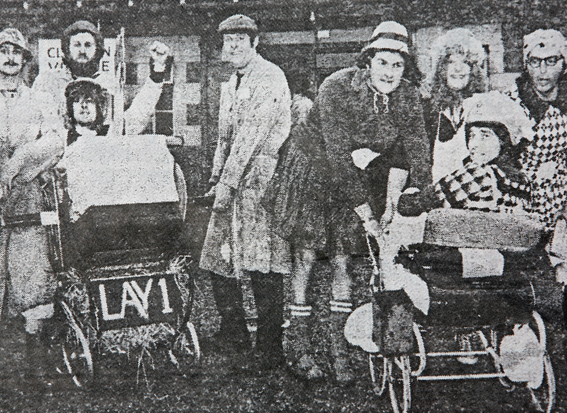
This photograph was captioned ‘Rock-A-Bye-Baby: Contestants in the Clutton Pram Race get into the spirit’ and was dated May 5, 1978. Here is an extract from the accompanying article:
“On a grey, drizzly day, the colourful spectacle as almost 30 prams with runners and occupants lined up at the start, brought quite a few smiles to the faces of the holiday drivers held up in traffic queues on the A37. Landlady Molly Robinson, of the Warwick Arms, had hardly blown the whistle when the teams, complete with decorated prams, had their first massive pile-up just yards from the starting line. Best dressed on the day was the Clutton Methodist Sunday School with its flying doctor outfits.â€
Â
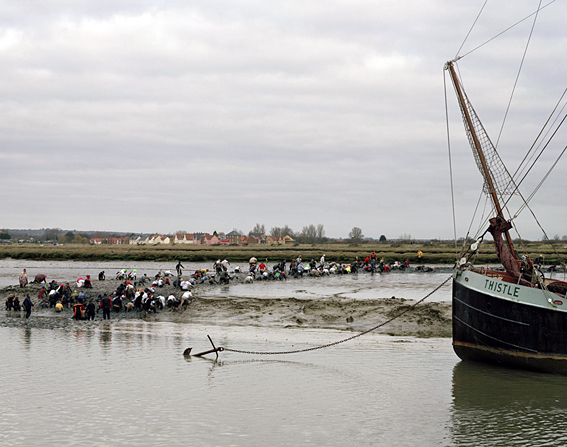
Mad Maldon Mud Race, Maldon, Essex, December 31st 2007
These mildly eccentric English pastimes seem to be enjoying a revival in recent years. It could also be noted that pubs and the consumption of alcohol play a prominent role in them. Is this in itself peculiarly English? In fact, the Mad Maldon mud race, which I photographed in December, began as a result of a drunken conversation in the local pub, where one man challenged another to run across the mud flats and has since metamorphosised over the years into an annual race where a couple of hundred people get down and dirty squelching across the mud before celebrating in the pub afterwards.
Â
Posted in EVENTS & PASTIMES | 1 Comment »
During a brief stop in Oxford this weekend I went along to the filming of The Antiques Roadshow at the University’s Hertford College. AR, as it’s affectionately known to its legions of fans, is one of the most popular factual programmes on British television, with an average audience of just under six million. It broadcasts 26 episodes a year coming from locations all over the country.
Â
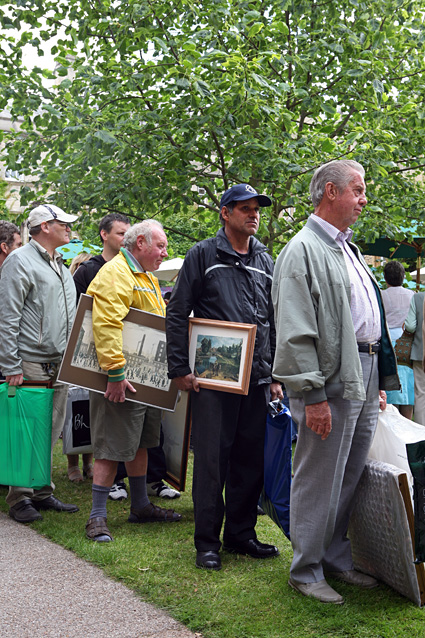
There was a large queue of people hoping to gleen some facts about their family heirlooms and, lets be honest, a valuation, from the resident AR experts. Punters included Lawson, from Oxford, with his print of Constable’s Flatford Mill and John, from Abingdon, with a Lowry.
Â
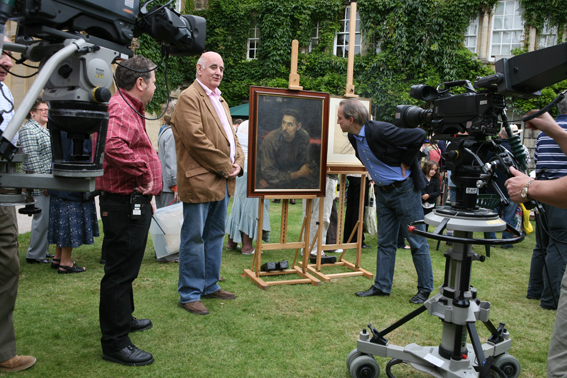
One member of the public, seen above, received slightly better news than Lawson and John. Here AR expert Philip Mould inspects an original sketch by the Russian artist Ilya Repin (dated 1917) which he valued at £200,000, making it one of the most important finds in the programme’s thirty year history!
Â
Posted in EVENTS & PASTIMES | 1 Comment »















